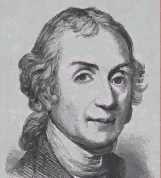

Joseph Priestley was born in 1833 about six miles from Leeds. He came from quite a poor family and from the age of seven, following the death of his mother, he was raised by his aunt. He was sent to Batley Grammar School where he studied Latin and Greek; he later acquired understanding of French, German, Italian and Hebrew as well as the Syriac and Chaldean variants of Aramaic. On the strength of this he became tutor in languages at Warrington Academy. Whilst there he met and married his wife Mary. At this time too he was ordained.
Priestley was a self-taught scientist and was soon demonstrating original experiments in electricity and optics (he was later encouraged by Benjamin Franklin to write a book on the history of electricity). In 1766 he was elected a Fellow of the Royal Society. In 1767 he became the minister of Mill Hill Chapel in Leeds where he also helped to establish the Leeds Library. Here he turned to chemistry and, being near a brewery, he began to investigate �fixed air� (carbon dioxide) which was produced during fermentation. At this time only three gases were known: air, carbon dioxide (studied by Joseph Black), and hydrogen (studied by Henry Cavendish). Priestley later experimented with, and in several cases discovered, hydrochloric acid gas, nitrogen, nitrous oxide, nitrogen peroxide, ammonia, carbon monoxide, sulphur dioxide, silicon fluoride, and, most famously, oxygen (Carl Scheele had discovered it earlier but published his discovery only in 1777 - three years after Priestley).
Many of these discoveries have led to important applications: carbon dioxide dissolved in water is the basis of all carbonated drinks (for this Priestley was awarded the Copley Medal); ammonium compounds were later used in fertilisers and explosives; nitrous oxide is the important anaesthetic �laughing gas�; nitric oxide is a valuable respiratory stimulant recently used, routinely, with new-born infants having breathing problems - the complete list is very long.
Priestley pioneered the method of collecting gases by bubbling through water and collecting in an inverted gas jar by water displacement (or mercury in the case of water soluble gases) - the classic pneumatic trough, beehive shelf, and gas jar familiar now to most school pupils. He heated materials, in a glass retort, by concentrating sunlight using a twelve-inch diameter convex lens. Most chemists at this time used a candle to heat materials in a porcelain flask which, being porous, produced air contamination.
In his most famous experiment, Priestley produced oxygen by heating red mercury calx (mercuric oxide) which dissociates into metallic mercury and oxygen. The reaction is reversible: if mercury is heated ir again forms mercuric oxide. Priestley found that breathing pure oxygen was beneficial but did not understand the role of oxygen in breathing (Lavoisier, who did, soon also showed that breathing produces water and carbon dioxide). Priestley also showed that green plants give off oxygen in sunlight, os he actually discovered photosynthesis, but he had no means of understanding the mechanism.
Priestley believed in the phlogiston theory of combustion (originally proposed by Johann Becher in 1669 and developed by Georg Stahl who invented the name phlogiston in the early 1700s). According to this theory, substances that could be burnt contained phlogiston which they gave off into the air during burning. In a similar way, mercury would give off phlogiston when converted to ash or calyx. When Priestley heated this calx (mercuric oxide) he thought it reformed mercury by re-absorbing pholgiston from the surrounding air; this air which he collected (ie oxygen) he therefore called �dephlogisticated air�. According to this reasoning, mercury calx in mercury minus phlogiston and should, therefore, weigh less than mercury.
When Priestley visited Paris, he described his experiment to the French chemist, Antoine Lavoisier who repeated the experiment and showed that mercury calx actually weighed more than the original metal (this had been shown some time earlier).
Lavoisier correctly deduced that when substances burned they actually combined with Priestley�s gas which he renamed oxygen. He also showed that this oxygen constitutes approximately one fifth of atmospheric air. These discoveries, which revolutionised the theory of combustion, were due both to Lavoisier�s insight and his careful measurement. Priestley had never really appreciated the importance of quantitative methods (though he did sometimes measure volumes of gases). Nor did he accept Lavoisier�s reasoning. He died a believer in phlogiston theory which his own experiments had helped to destroy.
Priestley had a great curiosity, a fine intelligence and a real love of science. His knowledge, across most fields of science at that time was very wide but not always correspondingly deep. His strength was his experimental work; he modestly wrote ��it is not my opinions on which I would be understood to lay any stress. Let the new facts from which I deduce them be considered as my discoveries and let other persons draw better inferences from them if they can.�
Priestley wrote hundreds of publications embracing science, religion, politics, philosophy, education and language, but the most important thing in his life was his religion. All his other works have to be considered in the light of his unwavering dedication to his non-conformist Unitarianism. Unlike Descartes, who divorced faith and reason (the spiritual and the material), Priestley alwys tried to unite them - this is why his various mental activities in so many fields of knowledge always had a single purpose. As a non-conformist, he suffered a great deal for his beliefs. When he left Leeds and later went to Birmingham, his house was burnt down by an angry mob and he ended his life an exile in America as a rather sad and lonely man.